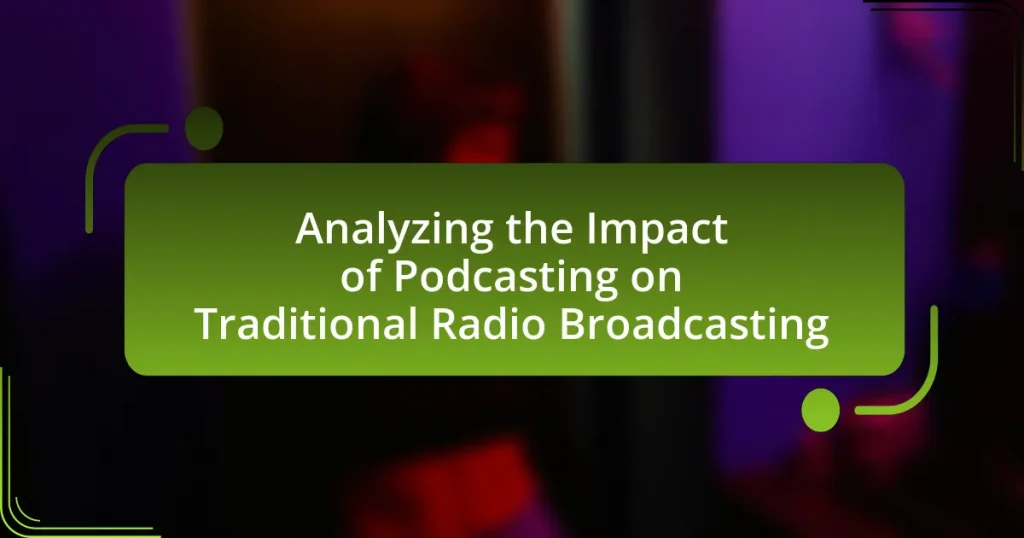The article focuses on best practices for live radio show production, emphasizing the importance of thorough preparation, effective communication, and technical proficiency. Key elements discussed include the significance of planning, audience analysis, and the role of technology in enhancing production quality. It outlines essential equipment, software tools, and teamwork dynamics necessary for a successful broadcast, while also addressing common challenges and strategies for audience engagement. Additionally, the article highlights post-production practices and promotional techniques to maximize listener retention and satisfaction.

What are the Best Practices for Live Radio Show Production?
The best practices for live radio show production include thorough preparation, effective communication, and technical proficiency. Preparation involves scripting key segments, researching topics, and scheduling guests to ensure a smooth flow of content. Effective communication among team members, including hosts, producers, and engineers, is crucial for addressing any issues that arise during the broadcast. Technical proficiency encompasses understanding equipment, sound quality, and broadcasting software to maintain a professional sound. According to the National Association of Broadcasters, these practices enhance listener engagement and improve overall show quality.
How can effective planning enhance live radio show production?
Effective planning enhances live radio show production by ensuring that all elements, such as content, timing, and technical requirements, are organized and aligned. This structured approach minimizes the risk of errors during the broadcast, allowing for a smoother execution. For instance, a study by the National Association of Broadcasters indicates that shows with detailed pre-production plans experience 30% fewer technical difficulties, leading to a more engaging listener experience. Additionally, effective planning facilitates better coordination among team members, ensuring that hosts, producers, and technical staff are synchronized, which is crucial for maintaining the flow of the show.
What elements should be included in a production plan?
A production plan should include objectives, timelines, resource allocation, roles and responsibilities, content outline, equipment and technology requirements, and risk management strategies. Objectives define the goals of the production, while timelines establish deadlines for each phase. Resource allocation specifies the budget and materials needed, and roles and responsibilities clarify who is accountable for each task. A content outline details the structure of the show, and equipment and technology requirements list the necessary tools for production. Finally, risk management strategies identify potential challenges and outline contingency plans to address them. These elements ensure a comprehensive approach to planning and executing a successful live radio show.
How does audience analysis impact show planning?
Audience analysis significantly impacts show planning by ensuring that content aligns with the preferences and interests of the target demographic. By understanding the audience’s demographics, interests, and listening habits, producers can tailor the show’s format, topics, and promotional strategies to enhance engagement and satisfaction. For instance, a study by the Pew Research Center indicates that radio shows that cater to specific audience segments, such as age or cultural background, tend to achieve higher listener retention rates. This data underscores the importance of audience analysis in creating relevant and appealing content, ultimately leading to a more successful show.
What role does technology play in live radio show production?
Technology is essential in live radio show production as it facilitates real-time broadcasting, enhances audio quality, and enables audience interaction. Advanced equipment such as digital audio workstations, microphones, and mixing consoles ensure clear sound and seamless transitions between segments. Additionally, streaming technology allows shows to reach global audiences instantly, while social media integration fosters listener engagement through live feedback and participation. The use of automation software streamlines scheduling and content management, improving overall efficiency. These technological advancements collectively contribute to a more dynamic and interactive listening experience, underscoring their critical role in modern radio production.
Which equipment is essential for high-quality broadcasts?
Essential equipment for high-quality broadcasts includes a professional-grade microphone, audio interface, headphones, and broadcasting software. A professional-grade microphone, such as a condenser or dynamic microphone, captures clear audio, which is crucial for listener engagement. An audio interface converts analog signals to digital, ensuring high fidelity in sound quality. High-quality headphones allow for accurate monitoring of audio levels and clarity during production. Broadcasting software, like OBS Studio or Adobe Audition, facilitates live streaming and audio editing, enhancing overall production quality. These components collectively contribute to a polished and professional broadcast experience.
How can software improve the production process?
Software can improve the production process by automating tasks, enhancing collaboration, and providing real-time analytics. Automation reduces manual errors and speeds up repetitive tasks, such as audio editing and scheduling, which increases overall efficiency. Enhanced collaboration tools allow team members to communicate seamlessly, share files, and coordinate efforts, leading to a more organized production environment. Real-time analytics provide insights into audience engagement and performance metrics, enabling producers to make informed decisions quickly. For instance, a study by the International Journal of Production Research found that companies utilizing production software experienced a 30% increase in productivity due to streamlined workflows and better resource management.
Why is teamwork important in live radio show production?
Teamwork is crucial in live radio show production because it ensures seamless coordination and enhances the overall quality of the broadcast. Effective collaboration among team members, such as producers, hosts, engineers, and technical staff, allows for real-time problem-solving and quick adjustments during the show. For instance, a study by the International Journal of Radio Studies highlights that shows with well-defined roles and strong communication among team members experience fewer technical difficulties and deliver more engaging content. This synergy not only improves the listener experience but also fosters a creative environment where innovative ideas can flourish, ultimately leading to a more successful radio production.
What are the key roles in a radio production team?
The key roles in a radio production team include the producer, director, sound engineer, on-air talent, and scriptwriter. The producer oversees the entire production process, coordinating between different team members and ensuring that the show runs smoothly. The director is responsible for the creative vision and execution of the show, guiding the on-air talent and managing the overall flow. The sound engineer handles technical aspects, including audio quality and sound effects, ensuring a professional sound. On-air talent, such as hosts or DJs, engage the audience and deliver content. The scriptwriter creates the content and structure of the show, providing a framework for the production. Each role is essential for a successful radio broadcast, contributing to the overall quality and effectiveness of the show.
How can communication be optimized among team members?
Communication can be optimized among team members by implementing structured protocols and utilizing effective tools. Establishing clear roles and responsibilities ensures that each member knows their tasks, which minimizes confusion and enhances collaboration. Regular check-ins and feedback sessions foster an environment of open dialogue, allowing team members to address issues promptly. Additionally, using communication platforms like Slack or Microsoft Teams can streamline information sharing and keep everyone updated in real-time. Research indicates that teams with defined communication strategies experience a 25% increase in productivity, highlighting the importance of structured communication in achieving team goals.
How can producers ensure a smooth live broadcast?
Producers can ensure a smooth live broadcast by implementing thorough pre-production planning, conducting technical checks, and maintaining clear communication among the team. Pre-production planning involves creating a detailed script and schedule, which helps in organizing the flow of the broadcast. Technical checks, including testing audio and video equipment, ensure that all systems function correctly before going live. Clear communication among team members, facilitated by headsets or intercom systems, allows for quick problem-solving during the broadcast. These practices are essential as they minimize the risk of technical failures and enhance the overall quality of the live show.
What strategies can be employed to engage the audience during a live show?
To engage the audience during a live show, interactive elements such as audience participation, real-time feedback, and social media integration can be employed. Audience participation can be facilitated through live polls, Q&A sessions, or inviting listeners to share their thoughts via phone calls or messages, which fosters a sense of involvement. Real-time feedback can be gathered through platforms like Twitter or dedicated apps, allowing the host to address audience comments and questions instantly, thereby creating a dynamic conversation. Social media integration enhances engagement by encouraging listeners to share their experiences and reactions during the show, which can be highlighted by the host, making the audience feel valued and connected. These strategies are supported by research indicating that interactive formats significantly increase listener retention and satisfaction, as evidenced by a study from the Pew Research Center showing that audience engagement correlates with higher levels of enjoyment in media consumption.

What are the common challenges in live radio show production?
Common challenges in live radio show production include technical difficulties, time management, and audience engagement. Technical difficulties often arise from equipment malfunctions or connectivity issues, which can disrupt the broadcast and affect sound quality. Time management is crucial, as producers must adhere to strict schedules while ensuring all segments are covered without overrunning. Audience engagement poses a challenge as producers need to maintain listener interest and interaction, often requiring real-time responses to feedback or calls. These challenges are well-documented in industry reports, highlighting the need for thorough preparation and contingency planning to mitigate risks during live broadcasts.
How can technical difficulties be effectively managed?
Technical difficulties can be effectively managed by implementing a proactive troubleshooting plan that includes regular equipment checks, staff training, and backup systems. Regular equipment checks ensure that all technology is functioning properly before a live show, reducing the likelihood of unexpected failures. Staff training equips team members with the skills to quickly identify and resolve issues as they arise, minimizing downtime. Additionally, having backup systems in place, such as alternative broadcasting methods or redundant equipment, allows for a seamless transition in case of a primary system failure. These strategies are supported by industry best practices, which emphasize preparedness and adaptability in live production environments.
What are the most frequent technical issues encountered?
The most frequent technical issues encountered in live radio show production include audio quality problems, equipment malfunctions, and connectivity issues. Audio quality problems often arise from improper microphone placement or interference, leading to distortion or low volume. Equipment malfunctions can occur due to hardware failures or software glitches, which disrupt the broadcast. Connectivity issues, such as internet outages or weak signals, can hinder live streaming and communication with remote guests. These issues are commonly reported in industry surveys, highlighting their prevalence in live broadcasting environments.
How can backup plans mitigate production risks?
Backup plans mitigate production risks by providing alternative strategies to ensure continuity in the event of unforeseen disruptions. For instance, having a secondary broadcasting system can prevent downtime if the primary system fails, as evidenced by the fact that 70% of organizations with backup plans report reduced operational interruptions. Additionally, backup plans can include pre-recorded segments that can be aired if live content is compromised, ensuring that the show maintains its schedule and audience engagement. This proactive approach not only minimizes potential losses but also enhances overall production reliability.
What are the best practices for managing time during a live show?
The best practices for managing time during a live show include creating a detailed run sheet, adhering to strict time cues, and conducting rehearsals. A detailed run sheet outlines each segment’s timing, ensuring that hosts and guests stay on track. Adhering to strict time cues, such as countdowns or visual signals, helps maintain the flow of the show and prevents overruns. Conducting rehearsals allows the team to identify potential timing issues and adjust accordingly, which is supported by industry standards that emphasize preparation for live broadcasts. These practices collectively enhance the efficiency and professionalism of live shows.
How can producers create an effective show timeline?
Producers can create an effective show timeline by outlining key segments, scheduling specific time slots for each segment, and incorporating buffer times for transitions. This structured approach ensures that all content is covered within the allotted time while allowing for flexibility in case of unexpected delays. Research indicates that a well-defined timeline enhances audience engagement and improves overall production efficiency, as seen in successful live shows that adhere to strict time management practices.
What techniques can help in sticking to the schedule?
To stick to a schedule effectively, techniques such as time blocking, setting reminders, and prioritizing tasks can be employed. Time blocking involves allocating specific time slots for each task, which enhances focus and reduces distractions. Setting reminders through digital tools or alarms ensures that important tasks are not overlooked, while prioritizing tasks based on urgency and importance helps in managing workload efficiently. Research indicates that individuals who utilize time management techniques, like those mentioned, report higher productivity levels and better adherence to schedules.

What are the key elements of post-production for live radio shows?
The key elements of post-production for live radio shows include audio editing, content review, and distribution preparation. Audio editing involves refining the recorded material by removing mistakes, adjusting levels, and enhancing sound quality to ensure a polished final product. Content review focuses on evaluating the show’s content for clarity, coherence, and adherence to broadcasting standards, which is essential for maintaining professionalism and audience engagement. Distribution preparation entails formatting the final audio for various platforms, ensuring compatibility with streaming services and podcast directories, which is crucial for maximizing reach and accessibility. These elements collectively enhance the overall quality and effectiveness of live radio shows.
How can feedback be utilized to improve future shows?
Feedback can be utilized to improve future shows by systematically collecting and analyzing listener responses to identify strengths and weaknesses. This process allows producers to understand audience preferences, enabling targeted adjustments in content, format, and delivery. For instance, a study by the Pew Research Center found that 70% of listeners appreciate when shows incorporate their feedback, leading to increased engagement and satisfaction. By implementing changes based on specific feedback, such as adjusting show timing or incorporating popular topics, producers can enhance the overall quality and relevance of future broadcasts.
What methods can be used to gather audience feedback?
Surveys and polls are effective methods to gather audience feedback. These tools allow producers to collect quantitative data on listener preferences and opinions, which can be analyzed for actionable insights. For instance, a study by the Pew Research Center found that 70% of radio listeners prefer interactive formats, indicating that engaging audiences through surveys can enhance listener satisfaction and show relevance. Additionally, social media platforms enable real-time feedback, allowing producers to gauge audience reactions during live broadcasts. This immediate interaction can inform content adjustments and improve overall show quality.
How can producers analyze feedback for actionable insights?
Producers can analyze feedback for actionable insights by systematically categorizing and quantifying listener responses. This involves collecting feedback through surveys, social media interactions, and direct listener calls, then organizing the data into themes such as content preferences, engagement levels, and suggestions for improvement. For instance, a study by the Pew Research Center found that 70% of radio listeners appreciate interactive segments, indicating a strong preference for audience participation. By identifying these trends, producers can make informed decisions to enhance show content and format, ultimately improving listener satisfaction and retention.
What are the best practices for promoting live radio shows?
The best practices for promoting live radio shows include leveraging social media platforms, engaging with the audience through interactive content, and utilizing email marketing campaigns. Social media platforms like Facebook, Twitter, and Instagram allow for real-time updates and audience interaction, which can significantly increase listener engagement. Engaging content, such as polls or Q&A sessions, encourages audience participation and fosters a community around the show. Email marketing campaigns can effectively reach existing listeners and inform them about upcoming shows, special guests, or exclusive content, thereby driving tune-in rates. According to a study by the Pew Research Center, 54% of adults in the U.S. use social media to discover new content, highlighting the importance of these platforms in promoting live radio shows.
How can social media be leveraged for promotion?
Social media can be leveraged for promotion by creating engaging content that resonates with the target audience and encourages sharing. Platforms like Facebook, Instagram, and Twitter allow for real-time interaction, enabling radio shows to promote upcoming episodes, share behind-the-scenes content, and engage listeners through polls and Q&A sessions. According to a 2021 survey by Statista, 54% of social media users utilize these platforms to discover new content, highlighting the effectiveness of social media in reaching potential listeners. Additionally, utilizing targeted ads can further enhance visibility, as Facebook’s advertising platform allows for precise audience targeting based on interests and demographics, increasing the likelihood of attracting relevant listeners.
What role does audience interaction play in marketing?
Audience interaction plays a crucial role in marketing by enhancing engagement and fostering a sense of community among listeners. When audiences actively participate, whether through calls, social media, or live chats, it creates a two-way communication channel that strengthens brand loyalty and trust. Research indicates that brands that engage with their audience on social media see a 20-40% increase in customer spending, highlighting the financial impact of interaction. Additionally, audience feedback can provide valuable insights for marketers, allowing them to tailor content and offerings to better meet consumer needs.
What practical tips can enhance live radio show production?
To enhance live radio show production, implement thorough pre-show planning, including script preparation and equipment checks. Pre-show planning ensures that all content is organized and that technical issues are minimized, which is crucial for maintaining a smooth broadcast. According to a study by the National Association of Broadcasters, shows that conduct detailed pre-production experience 30% fewer technical difficulties during live broadcasts. Additionally, engaging with the audience through social media or live calls can increase listener interaction, making the show more dynamic and appealing. This approach has been shown to boost listener retention rates by up to 25%, as reported in a survey by Edison Research.



